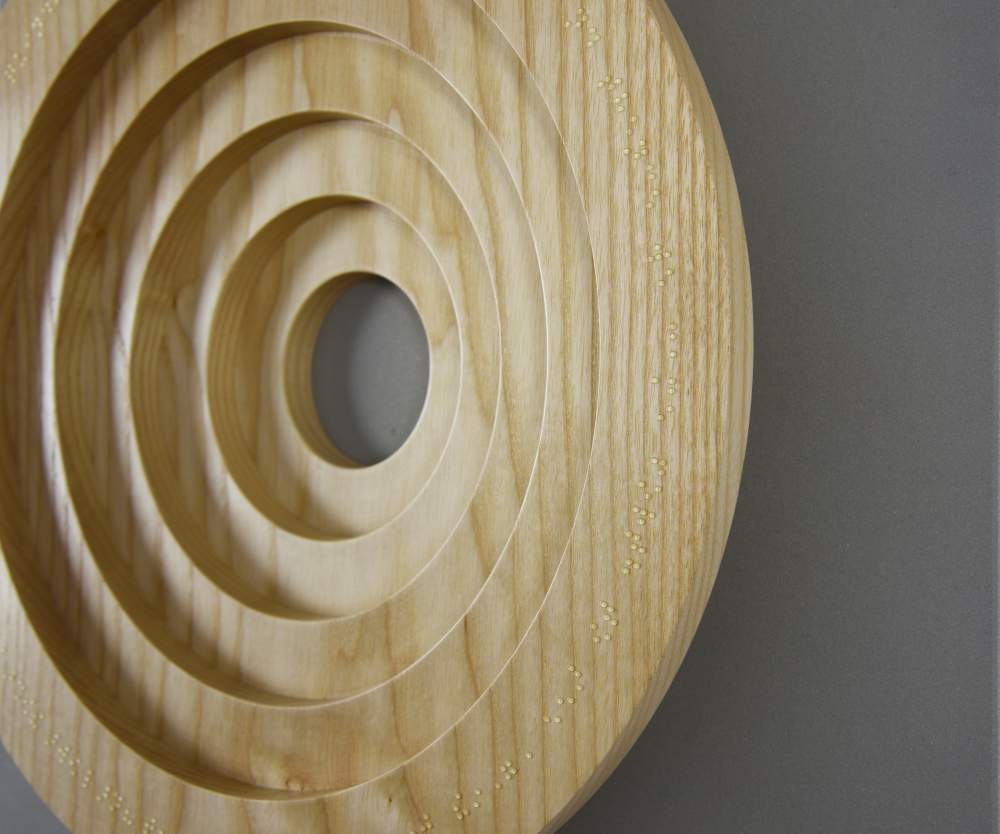In Milan, the painting-sculptures with braille writing by Fulvio Morella
Gaggenau DesignElementi in Milan is hosting until Feb. 25, 2022, Fulvio Morella ’s sculpture-paintings suspended between abstraction and architecture, between past and future, between matter and invisibility, on the occasion of the exhibition Pars Construens.
Curated by Sabino Maria Frassà, the exhibition gives visitors the opportunity to see and touch (with disposable gloves) works from the Blind Wood cycle in which the artist has combined turned wood and metal with braille writing. Braille celebrates its bicentennial this year, and it is this writing, employed in an ambivalent way, that is the focus of Morella’s works on display: on the one hand it forms decorative motifs, and on the other it is the key to understanding and interpreting the forms of the works, which are only abstract at first glance. Nothing you have in front of you is actually abstract, because all the works are built on the forms of famous places of the past re-employed and lived up to the present day: from the Amphitheater Square of Lucca to the Arena of Verona to the red domes of Palermo. Instead, it changes the point of view (aerial or lateral) that challenges the normal frontal visual approach to reality.
"Through a kaleidoscopic interplay of reflections and tactile experiences, Morella employs the history of architecture and braille to show us the relevance of the reflection of the English philosopher Bacon, who invented the expression Pars Construens, chosen as the title of the exhibition,“ explains curator Sabino Maria Frassà. ”These sculpture-paintings allow us to understand how in human history the propositional and constructive aspect always prevails in the end, the pars construens, capable of processing the past and what surrounds us to make something new out of it.“ ”Our cities,“ he continues, ”are the result of architectural layering, of a centuries-long operation of integrative assimilation, which most people ignore: from the plans of cities of Roman origin, to churches built on pagan temples or other earlier churches, to buildings constructed with the material of pre-existing ones. However, the artist does not limit himself to maquettes of well-known Italian monuments: the history of architecture is only the pretext, the starting point to tell how every aspect of our existence hinges on the pars construens. For this reason, the exhibition also presents works that tell a deeper existential syncretism: the ’Sing to me, O Muse’ that opens the exhibition is a clear and explicit invocation to preserve and nourish the past. Similarly, ’Perfume of-Wine’ invites us to reflect on the ethical relativism exemplified by the historical evolution of perfume from an element of worship to a symbol of vanity. Finally, the work Batea, a tribute to Dante on the anniversary of the seven hundredth anniversary of his death, tells us how the Italian language, too, is a magnificent unbroken path of millennial assimilation."
“To speak of the future,” the artist concludes. “means talking about an interminable and inexorable path of accrescitive assimilation of diversity in which limits are only relative and momentary. Human genius manages to rework everything and move forward.”
The Pars Construens exhibition continues the artistic journey entitled Extraordinario promoted by Gaggenau and CRAMUM in 2021 to tell a future of matter, beauty and progress inside Gaggenau DesignElementi spaces in Rome and Milan.
Hours: Monday through Friday from 10 a.m. to 6:30 p.m. Visits open to the public and by appointment only by email or phone contact:
E-mail: gaggenau@designelementi.it T. +39 02 29015250 (extension 4)
Image: Photo credits ©Francesca Piovesan - Courtesy Fulvio Morella, Gaggenau and Cramum
 |
| In Milan, the painting-sculptures with braille writing by Fulvio Morella |
Warning: the translation into English of the original Italian article was created using automatic tools. We undertake to review all articles, but we do not guarantee the total absence of inaccuracies in the translation due to the program. You can find the original by clicking on the ITA button. If you find any mistake,please contact us.





























